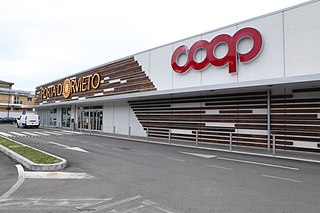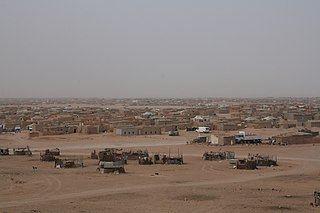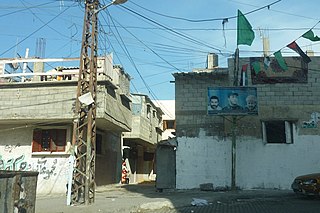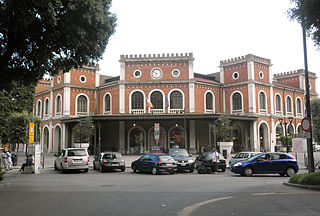Notes and references
- ↑ "Milan and Adriatica". United States Holocaust Memorial Museum. Archived from the original on 2002-02-13. Retrieved 2008-02-17.
Milan was a post World War II displaced person camp in the city of Milan, one of the few such camps in a major Italian city. The city also served as the administrative centre for refugees in northern Italy.
The camp housed 1,100 Jewish refugees, many of whom came from Austria along the illegal emigration routes organised by the Bricha. Milan placed more emphasis on education than the nearby Adriatica camp, setting up a secular school and a yeshiva religious school, and sharing kosher beef with the camp at Cremona. [1]
Milan is a major city in Italy.

Goma is the capital and largest city of the North Kivu Province in the eastern region of the Democratic Republic of the Congo (DRC). It is located on the northern shore of Lake Kivu, next to the Rwandan city of Gisenyi. It shares its borders with Bukumu Chiefdom to the north, the Republic of Rwanda to the east, Masisi Territory to the west, and is flanked by Lake Kivu to the south. The city lies in the Albertine Rift, the western branch of the East African Rift System, and lies only 13–18 km (8.1–11.2 mi) south of the active Nyiragongo Volcano. With an approximate area of approximately 75.72 square kilometers, the city has an estimated population of nearly 2 million people according to the 2022 census, while the 1984 estimate placed the number at 80,000.

Displaced persons camps in post–World War II Europe were established in Germany, Austria, and Italy, primarily for refugees from Eastern Europe and for the former inmates of the Nazi German concentration camps. A "displaced persons camp" is a temporary facility for displaced persons, whether refugees or internally displaced persons. Two years after the end of World War II in Europe, some 850,000 people lived in displaced persons camps across Europe, among them Armenians, Czechoslovaks, Estonians, Greeks, Poles, Latvians, Lithuanians, Yugoslavs, Jews, Russians, Ukrainians, Hungarians, and Belarusians.

Coop is a system of Italian consumers' cooperatives which operates one of the largest supermarket chains in Italy. Its headquarters are located in Casalecchio di Reno, Province of Bologna.

Bagnoli is a western seaside quarter of Naples, Italy, well beyond the confines of the original city. It is beyond Cape Posillipo and, thus, looking on the coast of the Bay of Pozzuoli.
Rafah Camp is one of eight Palestinian refugee camps in the Gaza Strip. It is located in the Rafah Governorate along the Gaza–Egypt border. It was established in 1949 and currently forms part of the city of Rafah. During the period of its establishment, it was the largest refugee camp in the Gaza Strip; however its population has decreased due to migration to the Tall as-Sultan camp, an extension of Rafah camp, which was set up to absorb refugees repatriated from Canada Camp.
Adriatica was a post World War II displaced person camp in northern Italy.

The Sahrawi refugee camps, also known as the Tindouf camps, are a collection of refugee camps set up in the Tindouf Province, Algeria in 1975–76 for Sahrawi refugees fleeing from Moroccan forces, who advanced through Western Sahara during the Western Sahara War. With most of the original refugees still living in the camps, the situation is among the most protracted in the world.
The Marka refugee camp is one of six emergency camps erected in 1968 to shelter 15,000 Palestinian refugees fleeing the West Bank and the Gaza Strip due to the 1967 Arab-Israeli war. Located in the Marka district of metropolitan Amman, about ten kilometers northeast of the city center, it is known locally as Hittin (حطين) or Schneller and houses 44,879 UNRWA registered refugees and over 17,500 displaced persons.

Al-Shati, also known as Shati or Beach camp, is a Palestinian refugee camp located in the northern Gaza Strip along the Mediterranean Sea coastline in the Gaza Governorate, and more specifically Gaza City.
Homs camp is a Palestinian refugee camp within the city of Homs, Syria, and around 160 kilometers (99 mi) north of Damascus. As of 2002, the camp had a population of 13,825 inhabitants.

The Milan–Venice railway line is one of the most important railway lines in Italy. It connects the major city of Milan, in Lombardy, with the Adriatic Sea at Venice, in Veneto. The line is state-owned and operated by the state rail infrastructure company, Rete Ferroviaria Italiana that classifies it as a trunk line. The line is electrified at 3,000 volts DC.

The Jenin refugee camp, also known as the Jenin camp, is a Palestinian refugee camp located in the city of Jenin in the northern West Bank. It was established in 1953 to house Palestinians who fled or were expelled from their homes by Israeli forces during and in the aftermath of the 1948 Palestine War. The camp has since become a stronghold of Palestinian militants, and has become known as "the martyr's capital" by Palestinians, and "the hornets' nest" by Israelis.

The Società per le strade ferrate dell'Alta Italia was an Italian railway company from 1865 to 1885.

The Società per le Strade Ferrate Meridionali was an Italian railway company established in 1862. In 1885 it took the control of the so-called "Rete Adriatica". In 1905 the Rete Adriatica was absorbed by Ferrovie dello Stato (FS), one year later the FS acquired all the lines of the SFM.
Rete Adriatica (RA) defines the network of railway lines assigned to the Società per le Strade Ferrate Meridionali under the Conventions of 1885. This network was merged into the Italian State Railways (FS) in 1905.

Piero Sacerdoti was an Italian insurer and university professor, general manager of Riunione Adriatica di Sicurtà in Milan from 1949 to his death.

Taranto railway station is the main station serving the city and comune of Taranto, in the region of Apulia, southern Italy. Opened in 1868, it forms a junction between three main lines, from Bari, Brindisi and Reggio di Calabria, respectively. It is also a terminus of a secondary line, the Bari–Martina Franca–Taranto railway.

Giuliano Pisapia is an Italian lawyer, politician, former mayor of Milan, former member of the Italian Parliament and member of the European Parliament. As a politician, he has been a member of two left-wing parties, first Proletarian Democracy and then the Communist Refoundation Party; in Milan's mayoral election, he was endorsed by a large left-wing coalition, after winning the primary election of the centre-left coalition with the strong support of Nichi Vendola's Left Ecology Freedom.

The Memoriale della Shoah is a Holocaust memorial at the Milano Centrale railway station commemorating the Jewish prisoners deported from there during the Holocaust in Italy. Jewish prisoners from the San Vittore Prison, Milan, were taken from there to a secret underground platform, Platform 21, to be loaded on freight cars and taken on Holocaust trains to extermination camps, either directly or via other transit camps. Twenty trains and up to 1,200 Jewish prisoners left Milan in this fashion to be murdered, predominantly at Auschwitz.